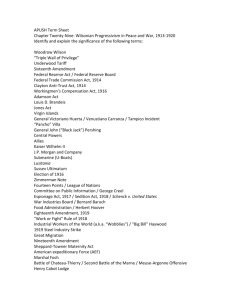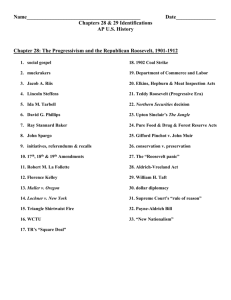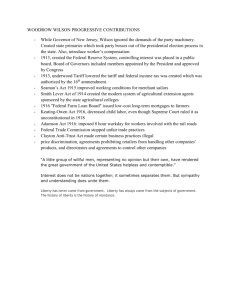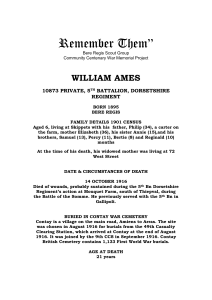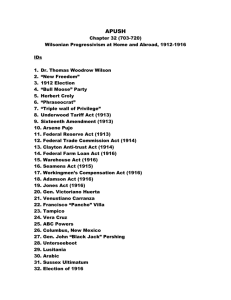HI136 The History of Germany
advertisement
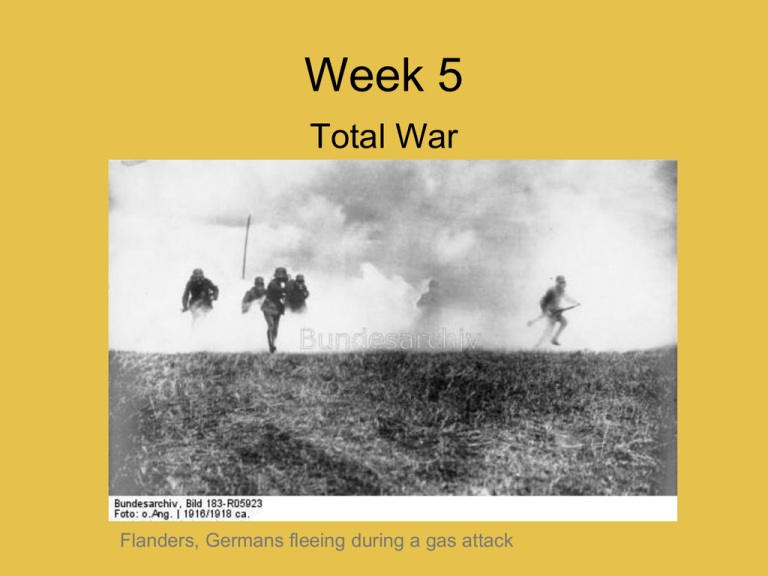
Week 5 Total War Flanders, Germans fleeing during a gas attack The Spark: The July Crisis • • • • • • • • • 28 June: Archduke Franz Ferdinand and wife Sophie assassinated at Sarajevo. 5 July: Kaiser Wilhelm II offers Germany’s unconditional support (the ‘blank cheque’) to Austria-Hungary. 23 July: Austria issues her ultimatum to Serbia. 28 July: Austria-Hungary declares war on Serbia. Russia orders ‘partial mobilisation’ of her armed forces. 30 July: Russia orders general mobilisation. Austria orders general mobilisation. 1 August: Germany declares war on Russia. France orders mobilisation. 2 August: Germany issues an ultimatum to Belgium, demanding to be allowed to move troops through Belgian territory. 3 August: Germany declares war on France. Italy proclaims her neutrality. 4 August: German troops cross the Belgian frontier. Britain declares war on Germany. Prewar Conditions • • • • • Balance of Power Weltpolitik Arms Race Nationalism/War Euphoria Domestic Pressures The Diplomatic Revolution, 1900-1907 Cartoon depicting Britain walking off with France, while Germany feigns disinterest. The Agadir Crisis (1911) The Balkan Wars (1912-13) • • • • First Balkan War (1912): Serbia, Greece, Bulgaria and Montenegro wrest control of Macedonia from Turkey. Second Balkan War (1913): Bulgaria attacks Serbia and is decisively defeated by the Greeks and Serbs. Anglo-German co-operation secures a settlement in the Balkans at the London Conference. Germany initially restrains Austria, but after 1913 she agrees to back her ally in any future confrontation with Serbia (and by extension Russia). Rearmament Source: Farmer & Stiles, The Unification of Germany 1815-1919 Burgfrieden / Civil Truce ”Ich kenne keine Parteien mehr, kenne nur noch Deutsche” I no longer know parties, I know only Germans. Map of Schlieffen Plan German troops charging into battle (above) and digging in to defensive positions (below) in the west, 1914 Paul von Hindenburg (18471934) • • • • • • • • • 1847: Born at Poznan in Prussian Poland, the son of an East Prussian landowner. Educated at cadet schools in Wahlstadt and Berlin. Fought at Königgrätz (1866) and in the Franco-Prussian War. 1878: Joined the General Staff. 1905: Promoted to the rank of General. 1911: Retired from active service. 22 August 1914: Brought out of retirement to command the German Eighth Army in East Prussia. Victory at Tannenberg and the Masurian Lakes made him a national hero. In many ways the archetypal Prussian Junker. The ‘Easterners’: Hindenburg, Ludendorff, Hoffmann and Mackensen by Oskar Bruch Trench Warfare The Battlefield in the Argonne Forest (1916) Postcard: Resting in the Trenches, c. 1914 Trench Warfare German troops attacking, July 1916 (Top Left), posed photograph of a ‘Storm Trooper’ (Bottom Left), German soldier wearing First World War trench armour (Above) Ernst Jünger • “In battle, the animal ascends as the secret horror at the soul’s base, shooting high as a consuming flame, an irresistible rapture that intoxicates the masses, a godhead enthroned above the hosts...” • “We’ve been harnessed and chiselled, but we are also such as swing the hammer and guide the chisel, we are at once the smith and the flashing steel.” In Stahlgewitten (‘Storm of Steel’, 1920) Erich Maria Remarque “A man cannot realize that above such shattered bodies there are still human faces in which life goes its daily round.” “I am young, I am twenty years old; yet I know nothing of life but despair, death, fear, and fatuous superficiality case over an abyss of sorrow.” (Nichts neues am Westen / All Quiet on the Western Front, 1928) Verdun (1916) Total War State Intervention • • • • • Walter Rathenau (1867-1922), industrialist and founder of the Kreigsrohstoffabteilung • 1915: Kreigsrohstoffabteilung (Raw Materials Department, KRA) – ensures the acquisition, storage and distribution of materials vital to the war effort. 1915: Bread rationing introduced. 1916: Zentral-EinkaufsGesellschaft (Central Purchasing Company) – acquisition of goods from neutral countries. 1916: Reichsgetreidstelle (Imperial Gain Office) – controlled food supplies and issued ration cards . Hindenburg Programme (1916) – Intended to concentrate industry on the production of munitions. Auxiliary Service Law (1916): Government could conscript workers and decide where they should work. “Krieg und Küche” Designer Käte Spanier Food Shortage Above Left: The first mobile kitchen (Gulaschkanone) in Berlin, c. 1916. Below Left: Queuing for food, 1917. Total War Agriculture lost more than 1/2 prewar manpower Industry lost approx. 1/3 by end of 1914 No-strike promises & higher wages attracted labor to war industries By end of war, women made up 1/3-1/2 of war industry labor force. Women faced double burden & postwar backlash. Mobilisation for ‘total war’ • • • • • War Raw Materials Office: coordination of industrial products. Food rationing in 1915. War Food Office 1916. Substitutes – cloth with paper fibres. Gaps in the labour force filled by women (emancipation – double burden). • Auxiliary Labour Law (1916): Government could conscript workers and decide where they should work. • ‘Dictatorship’ of Oberste Heeresleitung (OHL) – Hindenburg and Ludendorff – loss of influence for civil government and strengthening of army influence. Inadequacies in the Mobilisation for ‘total war’ • Scarcity of food, clothing, soap, and other basic goods. • Agricultural production fell, meat consumption only 12% of pre-war level. • Malnutrition and starvation – ‘turnip winter’ 1916/17 (consequence: up to 750,000 dead). • Polarisation: pro ‘Siegfrieden’ (victorious peace) with far reaching war aims, pro peace without contributions and annexations. • Middle Classes: pauperisation, living conditions closer to working class – but many now more nationalist, angst (loss of status) . • Working Class: spontaneous strikes in 1916 and 1917. What Victory Could Have Looked Like? Treaty of Brest Litovsk (March 1918) Russia lost most of its oil and cotton production 3/4 of coal & iron production 1/3 of railways and agriculture 1/3 of population including Ukraine, Finland, and Baltic States Treaty of Bucharest (May 1918) Romania returned or gave control of territories to Bulgaria (joined Central Allies) & AustriaHungary Also, gave control of its oil wells to Germany for 90 years. The Treaty of Brest-Litovsk (1918) Source: G. Layton, From Bismarck to Hitler: Germany, 1890-1933 Final Military Gamble: The Spring Offensive 1918 March 1918: early successes quickly checked by fresh American troops-approx. 1 million Americans sent to Europe By July, the Entente counterattacked August: Entente forces broke through German lines In the Face of Failure… Supreme Command placed the burden of defeat onto a civilian govt. headed by Prince Max von Baden. Social Democrat Philipp Scheidemann became first SPD minister of newly formed cabinet. 3 October: Max von Baden sued for peace and set in motion October reforms Dolchstoßlegende Stab in the Back Legend Philipp Scheidemann and Matthias Erzberger betray the troops. October Reforms • Brought together coalition of SPD, Center Party, and liberals • Abolition of Prussian three-class electoral system • Army brought under parliamentary control • Max von Baden’s cabinet still reliant on army’s cooperation. Hohenzollern empire remains in place… CASUALTIES OF THE WORLD WAR Known dead Russia Seriously wounded Otherwise wounded Prisoners or missing 2,762,064 1,000,000 3,950,000 2,500,000 1,611,104 1,600,000 2,183,143 772,522 1,427,800 700,000 2,344,000 453,500 AustriaHungary 911,000 850,000 2,150,000 443,000 Great Britain 807,451 617,714 1,441,394 64,907 Serbia 707,343 322,000 28,000 100,000 Italy 507,160 500,000 462,196 1,359,000 Turkey 436,924 107,772 300,000 103,731 Rumania 339,117 200,000 ...... 116,000 Belgium 267,000 40,000 100,000 10,000 United States 107,284 43,000 148,000 4,912 Bulgaria 101,224 300,000 852,339 10,825 15,000 10,000 30,000 45,000 4,000 5,000 12,000 200 Japan 300 ........ 907 3 Total 9,998,771 6,295,512 14,002,039 5,983,600 Germany France Greece Portugal

